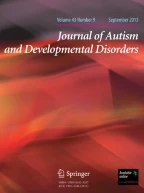Abstract
Though a sex difference in the incidence of autism has frequently been reported, few studies have considered sex differences in the severity of features associated with autism. The Autism Diagnostic Interview was used to assess the difference between a group of 21 females and 21 males with autism with equivalent chronological nonverbal IQ greater than 60. Males were rated to be more severely autistic than females on several measures of early social development, but not in any other areas. Results are discussed in relationship to hypotheses based on sex differences in other populations.
Similar content being viewed by others
References
Baird, T. D., & August, G. J. (1985). Familial heterogeneity in infantile autism.Journal of Autism and Developmental Disorders, 15, 315–322.
Bolton, P., & Rutter, M. (1990). Genetic influences in autism.International Review of Psychiatry, 2, 67–80.
Bryson, S. E., Clark, B. S., & Smith, T. M. (1988). First report of a Canadian epidemiological study of autistic syndromes.Journal of Child Psychology and Psychiatry, 29, 433–445.
Dilavore, P., & Lord, C. (1991, October).Sex differences in the familial transmission of autism spectrum disorders. Poster presented at the American Academy of Child and Adolescent Psychiatry, San Francisco.
Hollingshead, A., & Redlich, F. (1958).Social class and mental illness. New York: Wiley.
Krug, D. A., Arick, J., & almond, P. (1980). Behavior checklist for identifying severely handicapped individuals with high levels of autistic behavior.Journal of Child Psychology and Psychiatry, 21, 221–229.
Le Couteur, A., Rutter, M., Lord, C., Rios, P., Robertson, S., Holdgrafer, M., & McLennan, J. D. (1989). Autism Diagnostic Interview: A semistructured interview for parents and caregivers of autistic persons.Journal of Autism and Developmental Disorders, 19, 363–387.
Lord, C., Goode, S., Rutter, M., & Schopler, E. (1989). Sex differences in autism: Research news.International Journal of Rehabilitation Research, 12, 113–114.
Lord, C., & Schopler, E. (1985). Differences in sex ratios in autism as a function of measured intelligence.Journal of Autism and Developmental Disorders, 15, 185–193.
Lord, C., & Schopler, E. (1987). Neurobiological implications of sex differences in autism. In E. Schopler & G. Mesibov (Eds.),Neurobiological issues in autism (pp. 191–211). New York: Plenum Press.
Lord, C., Schopler, E., & Revecki, D. (1982). Sex differences in autism.Journal of Autism and Developmental Disorders, 12, 317–330.
Lotter, V. (1966). Epidemiology of autistic conditions in young children. I. Prevalence.Social Psychiatry, 1966, 124–137.
Raven, J. C. (1960).Guide to using the standard progressive matrices. London: H. K. Lewis.
Rutter, M., Le Conteur, A., & Lord, C. (in press). Autism Diagnostic Interview-Revised (ADI-R).Journal of Autism and Developmental Disorders.
Rutter, M., & Lockyer, L. (1967). A five to fifteen year follow-up study of infantile psychosis. I: Description of sample.British Journal of Psychiatry, 113, 1169–1182.
Schopler, E., & Reichler, R. (1979).Individualized assessment and treatment for autistic and developmentally disabled children. Vol. 1: Psychoeducation Profile. Baltimore, MD: University Park Press.
Schopler, E., Reichler, R., & Renner, B. R. (1986).The Childhood Autism Rating Scale (CARS) for diagnostic screening and classification of autism. New York: Irvington.
Spence, M. A., Ritvo, E. R., Marazita, M. L., Funderburk, S. J., Sparkes, R. S., & Freeman, B. J. (1985). Gene mapping studies with the syndrome of autism.Behavior Genetics, 15, 1–13.
Szatmari, P., & Jones, M. B. (1991). IQ and the genetics of autism.Journal of Child Psychology and Psychiatry, 32, 897–908.
Treffert, D. A. (1970). Epidemiology of infantile autism.Archives of General Psychiatry, 22, 431–438.
Tsai, L., Stewart, M. A., & August, G. (1981). Implications of sex differences in the familial transmission of infantile autism.Journal of Autism and Developmental Disorders, 11, 165–172.
Tsai, L., & Beisler, J. M. (1983). The development of sex differences in infantile autism.British Journal of Psychiatry, 142, 373–378.
Volkmar, F., & Szatmari, P. (1991, October).Sex differences in pervasive developmental disorders. Paper presented at the conference of the American Academy of Child Psychiatry, San Francisco.
Wing, L. (1981). Sex ratios in early childhood autism and related conditions.Psychiatry Research, 5, 129–137.
World Health Organization. (1987).ICD-10 1986 draft of chapter 5 categories F00-F99: Mental, behavioral and developmental disorders. Geneva: Author.
Author information
Authors and Affiliations
Additional information
This research was conducted with support of the Alberta Heritage Fund for Medical Research, the Medical Research Council of Canada, and PHS grant RO1 MH 46865-02. The cooperation of the families and individuals with autism is gratefully acknowledged, as well as the help of Linda Watson and Bruce Schaeffer in data collection and Deborah Dewey in data analysis.
Rights and permissions
About this article
Cite this article
McLennan, J.D., Lord, C. & Schopler, E. Sex differences in higher functioning people with autism. J Autism Dev Disord 23, 217–227 (1993). https://doi.org/10.1007/BF01046216
Issue Date:
DOI: https://doi.org/10.1007/BF01046216
